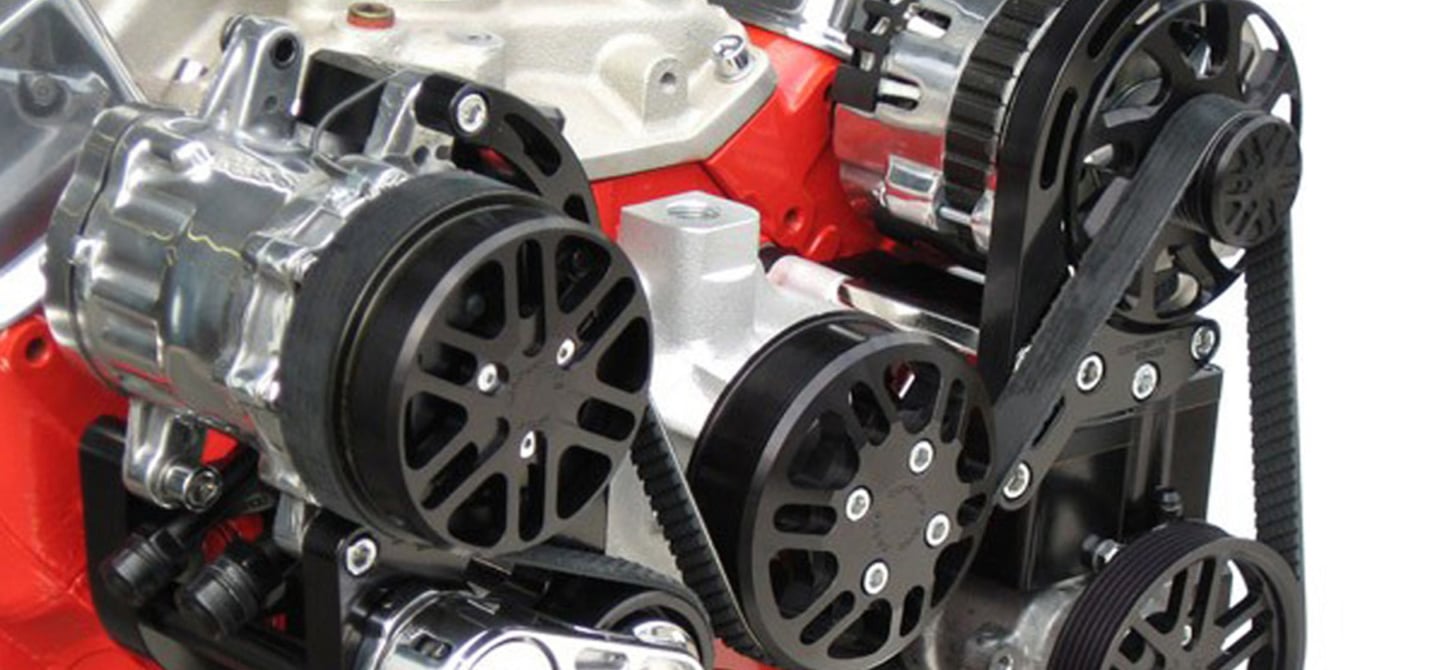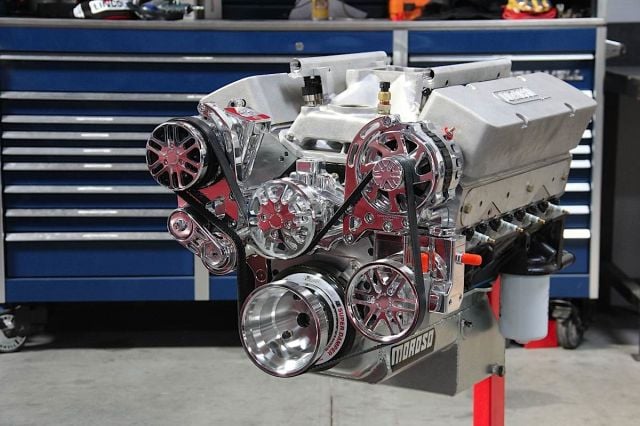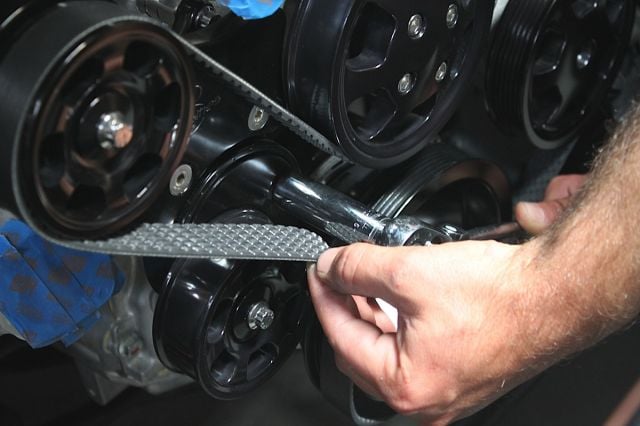It’s the 21st century. You’re reading this online – maybe even on your iPad. So, what is your classic Chevy doing with an old-school V-belt accessory-drive system? It’s time to step up to a modern serpentine-belt drive from any number of aftermarket specialists like Billet Specialties, Concept One, March Performance or Pace Performance, especially if you’re running – or plan to run – accessories such as power steering and air conditioning. There are plenty of advantages.
Heat is a vehicles worst enemy and it needs to dissipate efficiently and quickly. In fact, it’s one of the big reasons the serpentine-type system was developed in the first place. That’s because the thinner serpentine belt doesn’t retain heat like a thicker V-belt. And the serpentine belt’s strength and longevity are tied to its long, wide design, too, which has the properties of a long strand that is harder to break.
Serpentine systems also employ a tensioner, which keeps the optimal tension on the belt at all times and all engine speeds. It also helps dampen vibrations generated by the various engine-driven accessories. The advantages of a serpentine system are clear enough, but converting from a conventional V-belt accessory drive is more involved, but thankfully it’s a bolt-on project that any enthusiast with moderate wrench-turning experience can handle at home.
Conversion kits are plentiful and range from basic, including the pulleys, automatic tensioner, belts and basic accessories, to deluxe, with air conditioning and power steering pumps. The basic kits run only a few hundred bucks, but you’re looking at upwards of $1,800-$2,000 for a system that includes an air conditioning compressor. You can always scrounge a salvage yard for serpentine systems, too, but the quality of the accessories is always a gamble and you’ll likely have to replace some of the parts.
For most older vehicles/engines, you’re going to need to swap out the water pump, along with the accessory-drive pulleys. That’s because the water pumps used with GM serpentine systems turn the opposite way of early-style water pumps. The exception is some pulleys from March Performance, but more on that later.
Most kits include the correct water pump and buying such a comprehensive kit usually saves you more in the long run, despite a higher up-front cost. And if you’ve got more or higher-load electrical equipment on board, such as a couple of electric fans, a high-power stereo, etc., you’ll want a high-amp alternator to be part of the system, according to Billet Specialties’ Scott Sandoval.
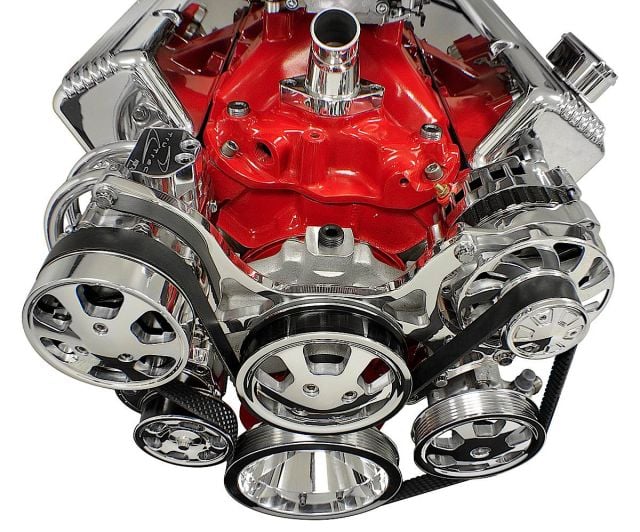
A serpentine belt conversion kit can add performance to your engine and life to the accessories. This system on a small-block Chevy is from Billet Specialties.
Even our very own '64 BluePrint Chevelle project car is benefiting from a complete, Billet Specialties serpentine kit on its LS powerplant. We ordered ours up with the optional, black finish.
“Our Tru Trac serpentine systems include a 140-amp Powermaster alternator that is designed for the electrical needs of today’s engines,” Sandoval explained, “It’s a great way to upgrade to a serpentine system and a higher-performance alternator all in one project.”
Overall, the installation is very straightforward and you don’t need any special tools – Scott Sandoval, Billet Specialties
There are universal reservoirs, but for only a couple of bucks, head to the nearest “pull your own” salvage yard and take a look under the hoods of different vehicles and find a reservoir that will fit the way you want.
“Overall, the installation is very straightforward and you don’t need any special tools,” says Sandoval. “Whether you’re installing a kit on a new engine on an engine stand or retrofitting onto the engine that’s in your classic Chevelle, it’s something anybody can do on a Saturday afternoon.”
Know Your Application:
Although most serpentine systems are generally universal for the type of engine – small-block, big block, etc. – installing one changes the dimensions of the front of the engine and that can have consequences under hood.
Check the block and heads against the mounting locations for the brackets in the kit – Chuck Fitch, Pace Performance
“If you’re putting a big-block in an old Chevy II or even a Tri-Five Chevy, the clearance can be tight – and it’s definitely easier on applications like that to do the serpentine conversion with the radiator out of the car.”
Redd also suggests talking with a consultant from serpentine system manufacturer to discuss the equipment on your car. Knowing that you’ll need a system with an air conditioning pump is obvious, but other factors come into play.
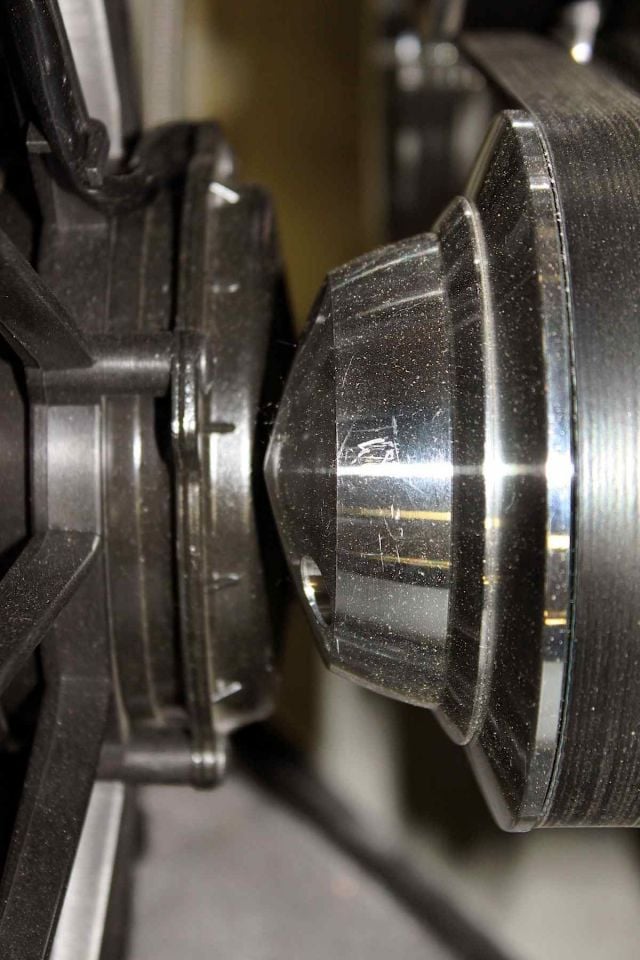
Front-of-engine dimensions are critical, too. You could barely slip a sheet of paper between this pulley and the electric fan module on this combination – let alone slip off the belt.
“If you’re running a rack-and-pinion steering system vs. an old steering gear, for example, can determine which power steering pump we include for your application,” he says. “And if you’re only running a single electric fan and no big stereo, you can probably get by with a 105-amp alternator instead of a 140-amp unit.”
Finally, Redd warns against making assumptions about universal systems. “Some kits out there bolt their brackets to the cylinder heads and that’s generally OK, but some Chevy heads, such as the double-humps, don’t have the bolt holes,” he says.
Redd added, “Our systems flat-out don’t bolt to the heads, which solves that problem altogether.” That sentiment is echoed by Chuck Fitch, of Pace Performance, who advised us with a few installation tips, including the mounting holes.
“Check the block and heads against the mounting locations for the brackets in the kit,” he says. “There are differences and there is nothing more frustrating than trying to get a bolt started in a hole that’s either not there or not in the correct position. Also, check the bolt hole size and test-fit the threads before installation the kit.”
Fitch also suggests having the engine’s plumbing decided prior to the final installation of the serpentine system. “We have many customers who assume that special adapters are available, but unfortunately find out they need to re-plumb or try to find special fittings,” he says.
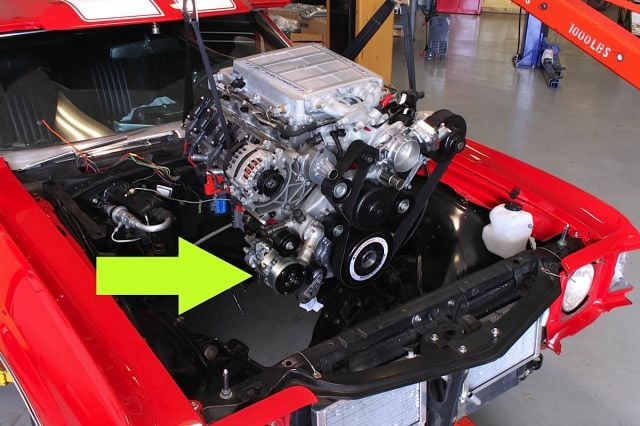
The factory’s low-mount position of the air conditioning compressor (arrow) is the biggest challenge for installing an LS engine with a serpentine system in an older car. Many companies, including March, Billet Specialties and Concept One, offer kits that relocate the compressor to a higher position.
LS Engine Considerations
If you’re installing an LS engine in a pre-LS-era vehicle, the serpentine belt system is mandatory – and may cause some installation anxiety – but it is unquestionably the wave of the future. Concept One’s Kevin Redd says LS serpentine kits are running neck and neck with small-block systems at his company and he expects them to overtake the small-block kits within a year.
We surveyed the big names in serpentine kits, including Billet Specialties, Concept One and March, and all offer kits designed for installation in older vehicles. The big Chevy retailer Pace Performance, carries kits from other manufacturers, too, including the GM-designed kits from Chevrolet Performance (formerly GM Performance Parts). Generally speaking, the watchword with almost all of these companies’ LS serpentine systems is “up” – i.e. mounting the accessories in a higher position.
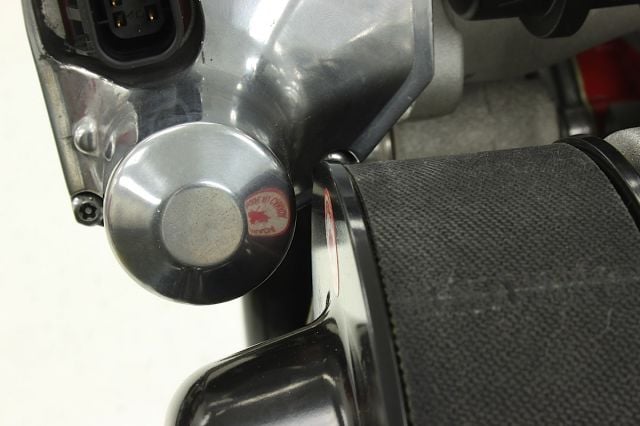
At the top of the engine – especially on fuel-injected LS engines with a protruding throttle body or supercharger – belt clearance can be tight, as well. Again, careful measurements are the key to an interference-free installation.
It’s necessary, because the stock serpentine drive system for most production LS engines places the alternator and air conditioning pump in low positions, which typically interfere with the front cross-member of many older vehicles – particularly A-bodies and early Camaros.
Custom brackets that elevate the mounting position do the trick, but you definitely don’t want to experiment here. We know of some rodders who’ve had luck using salvage parts from early-LS AC-delete trucks, but they’re almost impossible to find. And if you really don’t want air conditioning in the first place, the non-AC kits from Billet Specialties, Concept One and March are more than reasonably priced.
They’re definitely the way to go. There are a couple of other considerations for LS engines: superchargers and engines with variable valve timing. When it comes to a bolt-on blower kit, the aftermarket serpentine system may or may not work them, so don’t make any assumptions – ask both the serpentine kit manufacturer and the blower manufacturer about compatibility.
Now, as for the compatibility of LS engines with variable valve timing (also known as cam phasing), most manufacturers, including March and Billet Specialties, don’t have kits to accommodate them, but Concept One does. These would include the LY6, L76 and L92 engines.
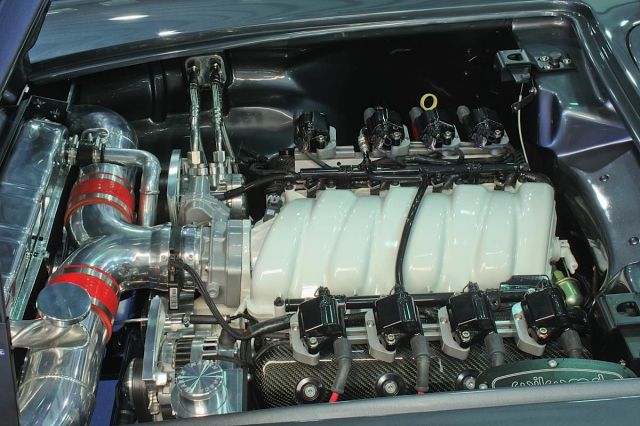
This LS-engine transplant in a vintage Corvette demonstrates an excellent application of a March Performance serpentine system, which has brackets that enabled the air induction tube that feeds the throttle body to come straight off the engine for a clean, low appearance.
And while it may not seem consequential, some serpentine systems are designed specifically for LS engines that use the traditional cable-actuated throttle or the “fly by wire” electronic throttle. Double check the manufacturer’s specifications before ordering.
If you want to stick with an all-GM setup, Chevrolet Performance offers a couple of kits: Part number 19155066, for LS1/LS6 engines and part number 19155067, which is designed for LS2 and LS7 engines. Each kit is comprehensive and includes the tensioner assembly, air conditioning compressor, power steering pump, power steering reservoir, alternator, all the accessories’ brackets and the belts (the A/C pump is driven separately). They are good, OE-quality kits, but lack the appearance options of the aftermarket manufacturers and, in some cases, may not offer the chassis clearance needed in some older vehicles.
March’s Lower-Cost Alternative
March Performance has a long history of replacement underdrive pulleys for late-model performance vehicles. When it comes to retrofit kits for small- and big-block engines, March offers a number of options, including the full serpentine conversion with a reverse-flow water pump in the kit, just like the other major manufacturers.

Measurements are important before installing a serpentine conversion kit. This chart from March shows the key dimensions for the various accessories in a typical kit.
But the company also offers a range of lower-cost serpentine kits that blend the attributes of non-slip performance and other advantages without changing over to a reverse-flow water pump.
Essentially, these kits employ a couple of strategically positioned brackets and replacement pulleys for the crankshaft, water pump, alternator and, in some applications, the power steering pump, putting their pulleys all on the same plane. A separate belt may drive the power steering pump and/or air conditioning pump, depending on how the engine is equipped.
Another advantage of this setup is variable pulley sizes March offers, enabling greater horsepower in most cases, as well as the opportunity to turn the water pump a little faster to increase its flow rate. There are a number of pulleys, pulley finishes and bracket choices to select from, along with choices on a horsepower-oriented setup or one geared toward greater cooling performance. Our advice is to check out March Performance’s online catalog and start looking. There’s a lot to absorb and consider.
By the way, most of March’s serpentine kits that retain the use of the original water pump list for less than $400, although the more accessories on the engine, the higher the price – but it’s still a considerable reduction over the cost of a complete serpentine system with a reverse-flow water pump. They’re available for standard and “long” water-pump applications, too.
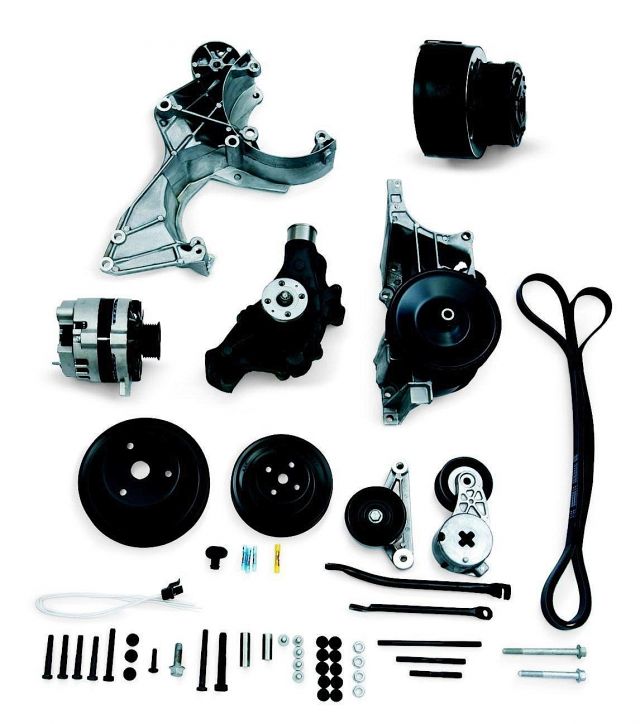
Serpentine conversion kits typically come complete with everything from the brackets and belt itself to specific accessories, including the water pump and alternator. On full serpentine conversion system for small-block and big-block engines, a reverse-rotation water pump is a must.
Appearance Is Everything
In addition to function, form is a big consideration when it comes to selecting a serpentine system. Machined, polished and anodized finishes are available from most manufacturers, although most of the systems from Chevrolet Performance have a decidedly OEM-cast appearance. March and Billet Specialties have long been known for their dress-up components, including polished pulley covers and brackets. Concept One matches them with a variety of appearance finishes.
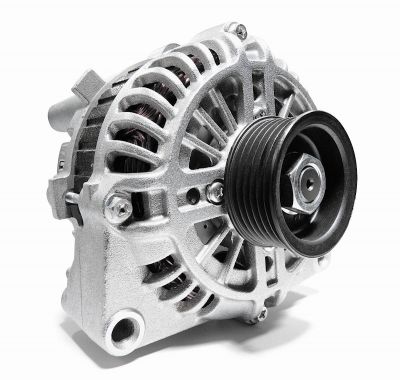
If your car doesn’t have more than one electric fan and a basic stereo system, you can probably get away with a 105-amp alternator, but if you’ve got a larger electrical load, make sure the serpentine kit you purchase comes with a 140-amp alternator.
With some kits, particularly those from March Performance, decorative pulley covers are available, which help dress the engine to complement carefully selected valve covers, intake manifold, air cleaner, etc. The caveat with these, however, is they add a little extra length to the pulley system, which can be an issue for vehicles with tight clearance between the radiator and engine.
Although not as flashy, the black-anodized finish offered by Billet Specialties, Concept One, as well as the black powder-coated finish available from March look great on pro-touring-type cars that convey a more modern aesthetic. We also like the idea of the black finish for resto-mod-type muscle cars, as it better approximates the look of original black V-belt pulley systems.
If, however, a more eye-catching design is what you’re looking for, March’s variety of finishes and bracket designs must be explored. There is something for just about every style and budget. Regardless of the engine you’re using or the vehicle you’re running it in, a serpentine belt system makes all the sense in the world. They offer greater performance and longevity, while adding a modern touch to a vintage car.
Don’t be intimidated by the conversion process, either. Yes, you’ll have to drain the cooling system to swap water pump and removing the old power steering pump can be a little messy, but hey, you’ve got crack a few eggs to make an omelette – just make sure you’ve got a drain pain and some kitty litter on the floor. If you can “wrap” yourself around the concept, this is a project even a novice can perform with great success.

Another kit from Concept One – this time on a small-block – shows how the polished pulleys perfectly complement the other brightwork on the engine, proving the serpentine system delivers on both form and function.


